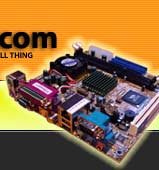|
EPIA MII 12000 Review
Video Playback Tests
Many people purchase EPIAs as multimedia playback
devices. There are several different media formats widely
available for purchase and download. Different formats are
encoded at varying degrees of compression - some easier to
decode than others. CLE266 EPIAs are optimised for MPEG2 decoding in hardware.
We chose 6 representative samples and checked
the CPU utilisation whilst playing back a movie at full screen
in 1024x768 resolution, with default playback quality
settings for DivX and XviD content. We watched for stutters, loss of
audio sync, bad picture quality and general nastiness. We didn't test with all the boards, instead choosing the EPIA MII 10000 and EPIA MII 12000 to see if the additional horsepower was beneficial.
We used Cyberlink PowerDVD
and the Core
Media Player for playback, and the Windows task manager
to measure CPU utilisation. Anything peaking at 100% is bad,
causing loss of picture or audio quality.
VCD Playback
Neither of the boards had difficulties playing
a VCD at full screen. VCD is a very loosely compressed MPEG1
format, requiring little CPU.
DVD Playback
The EPIAs all
had no problems, delivering a smooth, clear picture - as you
would expect from a chipset optimised for MPEG2 decoding.
Remember to turn the hardware acceleration in PowerDVD *on*
before playing DVDs for the first time on your EPIA.
SVCD Playback
SVCD is an MPEG2 based codec, and PowerDVD
was happy to use the hardware decoding of the EPIAs. SVCD
and VCD are both well defined formats, with standardised bit rates
for video and audio.
CPU utilisation was low here, with the classic peaks and troughs that come with fixed bit rate video playback. We opened our SVCD almost half way along this graph, after opening and closing a few windows first. DivX3 AVI Playback
Content in the DivX format abounds on the
internet and varies widely in quality and bit rates. There
are no fixed standards - one encoder might use the default
settings in their ripping program, another might perform all
manner of processing wizardry to squeeze the best picture
onto a 700MB CD. The EPIAs had
no such problems, producing smooth video straight from the
CD.
DivX4 with AC3 AVI Playback Our next choice was a DivX4 encoded movie
with an 1810 kBit/s video stream and 384 kBits/s AC3
audio stream. To pass this test, the CPU not only had to decompress
the video, but decode the surround sound too. Again, the EPIAs managed
without any loss of quality. This was probably the trickiest
DivX movie we could find, most movies are encoded at under 1000 kBit/s.
XviD with AC3 AVI Playback
Finally, we chose an XviD encoded movie with
AC3 to see what the differences were. Both boards produced
excellent results. CPU utilisation was near-identical on both boards - the graph above shows the peaks when opening a movie, and resizing it to full screen after a few seconds.
Optimising
Video Playback
Video codecs are increasingly efficient and encoding bitrates have become more standardised - we got better results playing back the same type of content than we did a year ago on the same boards.
Problems can still occur on any machine - but most video playback problems such as skipping and freezing are resolvable, often by some fairly simple software tweaks. There are several troubleshooting guides out there - these our current favourites for DivX and XviD:
DivX FAQ at divxmovies.com
XviD FAQ at xvidmovies.com
Measuring Audio Quality -->
|







